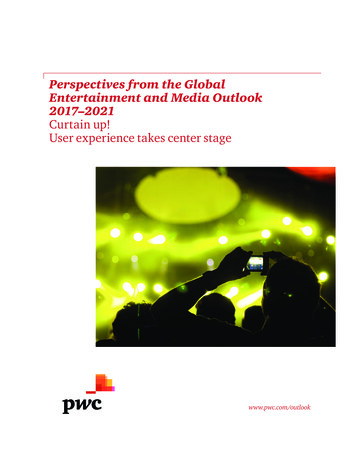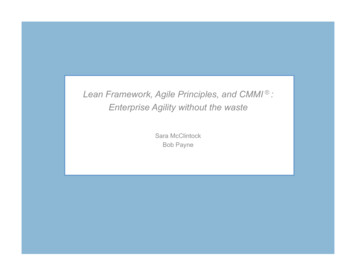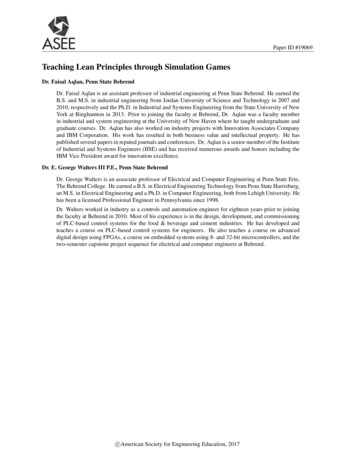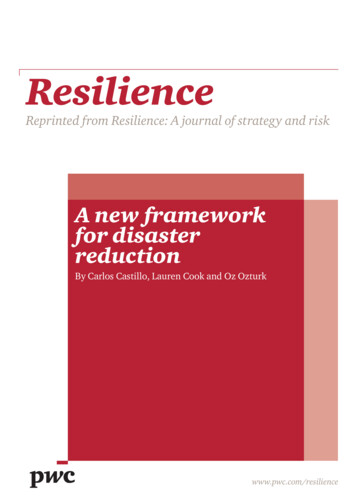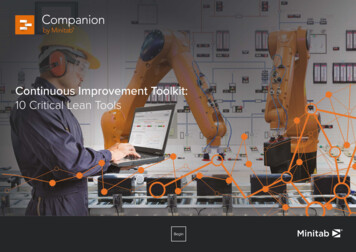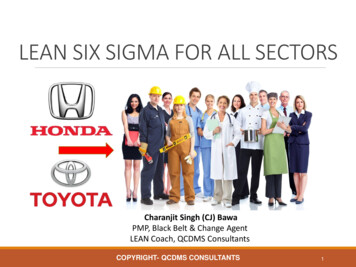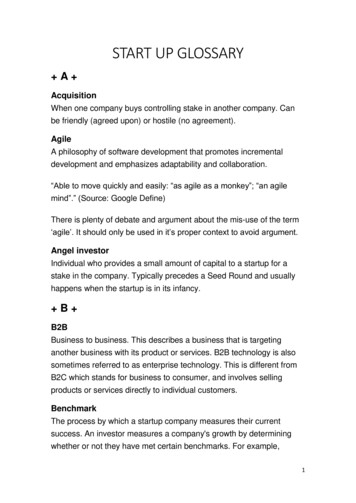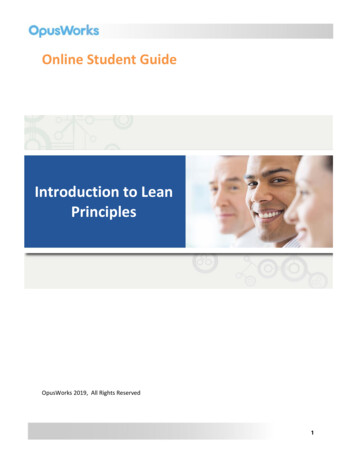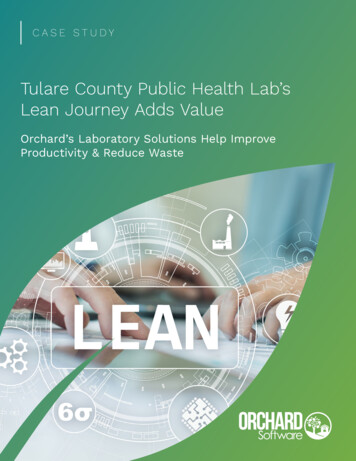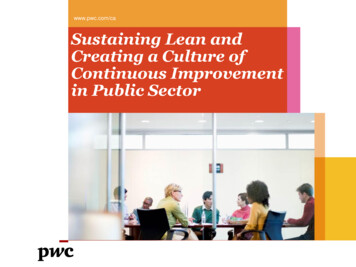
Transcription
www.pwc.com/caSustaining Lean andCreating a Culture ofContinuous Improvementin Public Sector
Agenda1. Lean and Continuous Improvement12. Lean Management System153. Sustaining Continuous Improvement – Case Studies20Sustaining Lean and Creating a Culture of Continuous ImprovementPwCOctober 20152
1. Lean and ContinuousImprovementSustaining Lean and Creating a Culture of Continuous ImprovementPwCOctober 20153
Lean and Continuous ImprovementLean is A business philosophy based on thefundamental goal of continuouslyminimizing waste and maximizing flow How do you sustain a Lean culture and a new way of working?Sustaining Lean and Creating a Culture of Continuous ImprovementPwCOctober 20154
Key issues in Public Sector today Limited funding/budgetaryconstraints Cost reduction Demographic changes – can’teasily replace people leaving Greater transparency onexpenditure and outcomes Need for operationalexcellence/efficiency Increasing demand for services Increasing regulations and risk Employees at all levels need to Focus on core and devolve nonbe engaged in service deliverycore servicesimprovement Need to work across Strategic culture change – needorganizational boundaries tofor culture of continuousimprove services and findexcellenceefficienciesSustaining Lean and Creating a Culture of Continuous ImprovementPwCOctober 20155
How Lean addresses these issues Removes wasteful work from processes Allows an organization to impact culture – create a culture ofcontinuous improvement and customer value Better utilize resources Enhances transparency and measures results Allows new capacity to be created Encourages senior managers to focus more on how work is gettingdoneLean creates and engaged workforce,drives simplification and focuses onproviding value to customersSustaining Lean and Creating a Culture of Continuous ImprovementPwCOctober 20156
Why Lean and Continuous Improvement fail?12345Perceived as ashort-termprogramMissingleadershipIntroduced asa managementhypeFocus ontools onlyFight symptomsinstead of rootcauses Restructuringapproach,results left fortomorrow No patience No dedicatedresources No vision ortargets Visiblemanagement andstaff division Lack of supportfrommanagement Assistant careswith part-timefor lean No clearlydefined targets Consequencesnot enforced No clear answeron how tohandle overstaff tomorrowSustaining Lean and Creating a Culture of Continuous ImprovementPwC No dedicatedteam Insufficientteamqualification Disconnectbetween toolsand employeesadopting Leanmindset Solve problemswith “morepeople” Resistanceagainsttransparency Lack of focus onhuman factors Firefighting fortemporarysolutionsOctober 20157
Effective Lean & Continuous Improvement (CI)capability building starts from the topLean & CI thinking and acting begins at management levelLeaders that exemplifyLean philosophyFoster and celebrateperformanceLean & CI thinking is aligned to the whole value streamIdentify keyimprovement prioritiesCover all areas andinterfacesLong term step-by-stepjourneyLean & CI stands for going on the ground and “learning to see”Respect, encourage &challenge employeesAll staff exemplify LeanphilosophyFoster a long termcollaborativeenvironmentLean & CI means to emerge employees as problem solversLearning organizationSustaining Lean and Creating a Culture of Continuous ImprovementPwCDeep understanding ofprocessesPrioritize and fact-baseddecision makingOctober 20158
Sustainable Lean and Continuous ImprovementMature Lean organizations have built their Lean andContinuous Improvement capability along four quadrantsKnowledge,Skills,BehaviorProcesses“How your staffis working”“What your staffknows and iskeen on”Lean & CICapabilityTools &SystemsOrganization“What supportsyour staff”“How your staffis organized intoa companystructure”Sustaining Lean and Creating a Culture of Continuous ImprovementPwCOctober 20159
Sustainable Lean and Continuous Improvement Clearly defined Lean roadmapContinuously improve established processesRegular waste analysis and eliminationPeriodic process improvement workshops Knowledge, Skills &ProcessesClearly understand corporate Lean strategy and visionContinuously seeking and eliminating wasteOpenness to change and trying new ways of workingSystematically coordinated Lean training at all levelsBehaviourSustaining Lean and Creating a Culture of Continuous ImprovementPwCOctober 201510
Sustainable Lean and Continuous Improvement Easily accessible Lean toolboxAdherence to defined standard work proceduresActive use of visual managementProcesses closely monitored, controlled, and activelyrectifiedTools &Systems Clear understanding of roles and responsibilitiesacross all levels to drive sustainable improvements Cross-functional organization to enable fullintegration of Lean for all employeesOrganizationSustaining Lean and Creating a Culture of Continuous ImprovementPwCOctober 201511
2. Lean Management System– Making the change stickSustaining Lean and Creating a Culture of Continuous ImprovementPwCOctober 201512
PwC Lean Management SystemOur unique solution targets changing the mindsets and behaviours of staffto enable sustainable performance improvementsNew Behaviours Management andleadership visibilityand presence Team leader coachingand driving teamperformance. Team membercontrol andresponsibilityManagementSystemsEffectiveness KPIs, performanceboards, performancereviews,competitions,recognition, vision,coaching, training,work load balancing Understanding thequality of the workthat is done, gettingthings right first timeSustaining Lean and Creating a Culture of Continuous ImprovementPwCEfficiency Managing capacityand removing theunnecessary parts ofthe process to reducethe time taken torespond to clients andimprove service levelsOctober 201513
A behavioral change methodology which delivers4 outcomes in a team culture g &Capability10 ElementsThe 10 ofLean ofelementsManagementPerformSystemRoutines &PracticesProcessConfirmationStandardsFocus oncapability1Visibility blemSolvingSustaining Lean and Creating a Culture of Continuous ImprovementPwC3Culturalchange leadingto CI2Management ofPerformance andworkloadOctober 201514
Need to optimize what managers do, how they doit, and the tools they use Typical ChallengesComplexity in how we work“We seem to have measures for everything – I don’t knowwhat’s important. Our processes are out of date and overlydetailed, so nobody uses them. We get lots of reworks”Disengaged Workforce“I’m not sure how I impact our department’s performanceand there isn’t an agreed way of doing things. I’m notmotivated by my line manager”The Blame Game“If only the front office would send us the right information,they just don’t understand”New Way of WorkingSimplicity in everything we do“We have a small number of KPIs which we constantlyreview. Following simple processes helps us do things quickerand right first time”Engaged Workforce“I know what is required of me on a day-to-day basis and cansee how it impacts my department. We follow standardprocesses and I am regularly coached by my line manager”Working together“Our daily huddles help us to quickly see problems. Weraise these as a team and work together to resolve them at ourlevel. We are now much more of a team”Fire-fightingActive Management“I work long hours fixing the latest issues. Going frommeeting to meeting, it never seems to stop”“I understand issues before they occur because of increasedvisibility of performance and control at the business line. Inow have time to visit sites to see for myself”Sustaining Lean and Creating a Culture of Continuous ImprovementPwCOctober 201515
3. Sustaining ContinuousImprovement – Case StudiesSustaining Lean and Creating a Culture of Continuous ImprovementPwCOctober 201516
Case Study 1 – Government of Saskatchewan –first government in Canada to implement Leangovernment-wideMinistry ofHealth PilotProjects20061SomeMinistries200922008Five HillsPilot Project3Select SchoolDivisions &Post-SecondaryInstitutions201042008-9All RegionalHealthAuthorities &Ministry ofHealthSustaining Lean and Creating a Culture of Continuous ImprovementPwC5All SchoolDivisions2013-1462012-13All Ministries782014-15Student FirstinitiatedOctober 201517
For Saskatchewan, it was all about Client Service – improve value for the customer Efficiency – minimize waste, increase productivity Safety – enhance safety for customers and employeesSustaining Lean and Creating a Culture of Continuous ImprovementPwCOctober 201518
Results More than 1,900improvement events670 in ministries1,100 in health28,000 employeestrainedTop 100 list ofimprovementstoriesTrainingQualitative170 in education 43M investment 208M costsavings/ avoidance270 FTEsproductivity gainsQuantitativeSustaining Lean and Creating a Culture of Continuous ImprovementPwCOctober 201519
Sustaining Lean and Creating a Culture of Continuous ImprovementPwCOctober 201520
Psychology Cycle Times141210.611.6Weeks1087.36.9June 2014June 20156420Baseline Jan2013June 2013Speech/Lang Path CycleTimes10.09.08.08.0Weeks7.06.05.35.35.2June 2013June 2014June 20155.04.03.02.01.00.0Baseline Jan 2013Sustaining Lean and Creating a Culture of Continuous ImprovementPwCOctober 201521
We work smarter, not harder, and themore we work with Lean, the moreimprovement we see.- Saskatchewan Government EmployeeSustaining Lean and Creating a Culture of Continuous ImprovementPwCOctober 201522
Case Study 2 – Healthcare Facilities ManagementClient Challenge Increasing work order backlog – impactedcustomer service expectations of the clinicalpartners, patient care and the stewardship ofthe physical assets Rising levels of customer complains Demand and preventative maintenancerequirements exceeded capacity to deliverOur Approach Increased leadership visibility at the shops toproactively lead their teams and walk the floor Improved two-way communication andprovided staff with the opportunity to regularlyidentify and develop solutions for existingchallenges Increased individual and teams’ performanceaccountability using visible targetsWhat Was Accomplished72% increase in average daily preventative maintenance work order completions29% improvement in average number work orders completed per week42% reduction in total work order backlog “I noticed an immediate increased level ofcommunication among members of the group at2 – 3 FTEs capacity gainthe morning huddles and a sense of ownership astheir problems and ideas were heard.”-- Maintenance ManagerSustaining Lean and Creating a Culture of Continuous ImprovementPwCOctober 201523
Case Study 3 – Driver LicensingClient Challenge Backlog of road test appointments Long customer wait times at DriverLicensing Offices Large volume of transactions Lack of capacity to handle additionalvolumeOur Approach Aligned capabilities, identified skill gaps anddrafted targeted training plans Standardized the work across the teams Provided tools to identify problems and developedsolutions that addressed the root causes Provided visibility into key performancemeasures giving teams daily insight to respond tocustomer changes in real-timeWhat Was Accomplished 33% decrease in average customer wait time from 17 minutes to 11.4 minutes 60% reduction in processing variability for transactions, resulting in consistent customerexperience 30% increase in operational capacity 13% increase in Driver Examiner productivitySustaining Lean and Creating a Culture of Continuous ImprovementPwC“Morale is higher than it has been in along time. My manager used to spend allof his time behind his computer; now Iactually see him” -- Team MemberOctober 201524
Case Study 4 – Transit authorityClient Challenge Lack of sufficient procurementmanagement and staff capacity Managers had limited visibility of thework being executed Significant stakeholders complaints Problems were rarely fully solved withwork-arounds continually beingimplementedOur Approach Trained managers to proactively lead their teams andincrease daily managerial visibility Designed and implemented capacity managementtools to balance workloads and resources across individuals Developed a supportive team dynamic Supported knowledge transfer and planned next steps tofacilitate the ongoing benefits realisation of thetransformation project.What Was Accomplished 22% increase in overall productivity 43% decrease in backlog 23% increase in handle volume “The Lean Management System we implemented with PwC’ssupport has drastically improved the way we do business”-- Director Procurement TransformationSustaining Lean and Creating a Culture of Continuous ImprovementPwCOctober 201525
Thank YouHaneef ChaganiPartnerPricewaterhouseCoopers LLPhaneef.chagani@ca.pwc.com(604) 806 7071Shelley WhiteheadLean Project OfficeGovernment of Saskatchewanshelley.whitehead@gov.sk.ca(306) 787 7619This content is for general information purposes only, and should not be used as a substitutefor consultation with professional advisers. 2015 PricewaterhouseCoopers LLP, an Ontario limited liability partnership. All rightsreserved.PwC refers to the Canadian firm, and may sometimes refer to the PwC network. Each memberfirm is a separate legal entity. Please see www.pwc.com/structure for further details.
Lean & CI thinking and acting begins at management level Lean & CI thinking is aligned to the whole value stream Lean & CI stands for going on the ground and "learning to see" Lean & CI means to emerge employees as problem solvers 8 Sustaining Lean and Creating a Culture of Continuous Improvement October 2015 Leaders that exemplify Lean .
